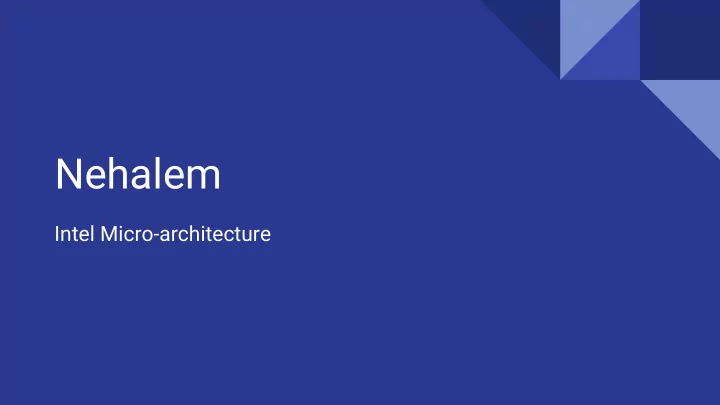

Nehalem Intel Micro-architecture
Features: Wide Dynamic Execution: • Every processor core can fetch, dispatch, execute and retire up to four instructions per clock cycle. • Advanced Smart Cache: improved bandwidth from the second level cache to the core, and improved support for single- and multi-threaded applications computation. Smart Memory Access: • which pre-fetches data from memory responding to data access patterns, reducing cache-miss exposure of out-of-order execution. • Advanced Digital Media Boost: for improved execution efficiency of most 128-bit SIMD instruction with single-cycle throughput and floating-point operations.
Instruction and Data Flow Process: The early stages of the processor fetch -in several macro-instructions at a • time. decode them into sequences of micro-ops. • The micro-ops are buffered at various places where they can be picked up • and scheduled to use in parallel if data dependencies are not violated. In Nehalem, micro-ops are issued to stations where they reserve their position for subsequent. dispatching as soon as their input operands become available. • Finally, completed micro-ops retire and post their results to permanent • storage.
Hardware impelementation four identical compute cores ● UIU: Un-Core Interface Unit (switch connecting the 4 cores to the 4 L3 cache ● segments, the IMC and QPI ports) L3: level-3 cache controller and data block memory ● IMC: 1 integrated memory controller with 3 DDR3 memory channels ● QPI: 2 Quick-Path Interconnect ports ● auxiliary circuitry for cache-coherence, power control, system management ● and performance monitoring logic
Software Access a 64-bit linear ( “ flat ” ) logical address space, ● uniform byte-register addressing, ● 16 64-bit-wide General Purpose Registers (GPRs) and instruction pointers ● 16 128-bit “ XMM ” registers for streaming SIMD extension instructions, in ● addition to 8 64-bit MMX registers or the 8 80-bit x87 registers, supporting floating-point or integer operations, fast interrupt-prioritization mechanism, ● a new instruction-pointer relative-addressing mode. ●
Front-End In-order Pipeline Retrieve blocks of macro-instruction from memory Translate instruction Handle instruction in-order Decode 4 instruction per cycle Decode instruction streams of threads in alternate cycles
Execution Engine Out-of-order Pipelines ● -Dynamically schedule micro- ops for dispatching and excution ● Dispatch up to 6 micro-ops per cycle ● Foure micro-ops can retire per cycle ● Result written-back rate up to one register per port per cycle
Recommend
More recommend